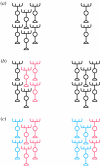The habenular nuclei: a conserved asymmetric relay station in the vertebrate brain
- PMID: 19064356
- PMCID: PMC2666075
- DOI: 10.1098/rstb.2008.0213
The habenular nuclei: a conserved asymmetric relay station in the vertebrate brain
Abstract
The dorsal diencephalon, or epithalamus, contains the bilaterally paired habenular nuclei and the pineal complex. The habenulae form part of the dorsal diencephalic conduction (DDC) system, a highly conserved pathway found in all vertebrates. In this review, we shall describe the neuroanatomy of the DDC, consider its physiology and behavioural involvement, and discuss examples of neural asymmetries within both habenular circuitry and the pineal complex. We will discuss studies in zebrafish, which have examined the organization and development of this circuit, uncovered how asymmetry is represented at the level of individual neurons and determined how such left-right differences arise during development.
Figures




References
-
- Adrio F., Anadon R., Rodriguez-Moldes I. Distribution of choline acetyltransferase (ChAT) immunoreactivity in the central nervous system of a chondrostean, the Siberian sturgeon (Acipenser baeri) J. Comp. Neurol. 2000;426:602–621. doi:10.1002/1096-9861(20001030)426:4<602::AID-CNE8>3.0.CO;2-7 - DOI - PubMed
-
- Aizawa H., Bianco I.H., Hamaoka T., Miyashita T., Uemura O., Concha M.L., Russell C., Wilson S.W., Okamoto H. Laterotopic representation of left–right information onto the dorso-ventral axis of a zebrafish midbrain target nucleus. Curr. Biol. 2005;15:238–243. doi:10.1016/j.cub.2005.01.014 - DOI - PMC - PubMed
-
- Aizawa H., Goto M., Sato T., Okamoto H. Temporally regulated asymmetric neurogenesis causes left–right difference in the zebrafish habenular structures. Dev. Cell. 2007;12:87–98. doi:10.1016/j.devcel.2006.10.004 - DOI - PubMed
-
- Andrew R.J., Osorio D., Budaev S. Light during embryonic development modulates patterns of lateralization strongly and similarly in both zebrafish and chick. Phil. Trans. R. Soc. B. 2009;364:983–989. doi:10.1098/rstb.2008.0241 - DOI - PMC - PubMed
-
- Araki M., McGeer P.L., Kimura H. The efferent projections of the rat lateral habenular nucleus revealed by the PHA-L anterograde tracing method. Brain Res. 1988;441:319–330. doi:10.1016/0006-8993(88)91410-2 - DOI - PubMed
Publication types
MeSH terms
Substances
Grants and funding
LinkOut - more resources
Full Text Sources

